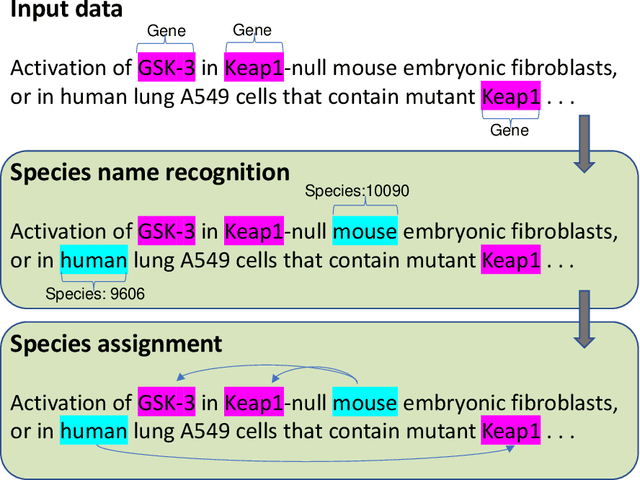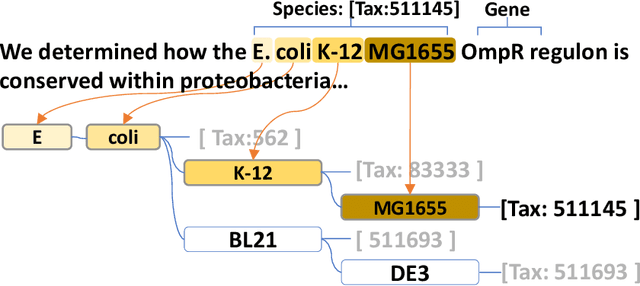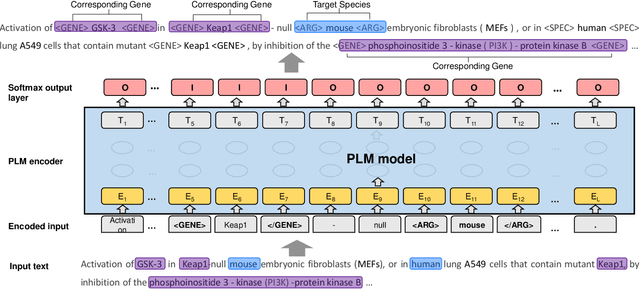Po-Ting Lai
Enhancing Biomedical Relation Extraction with Directionality
Jan 23, 2025Abstract:Biological relation networks contain rich information for understanding the biological mechanisms behind the relationship of entities such as genes, proteins, diseases, and chemicals. The vast growth of biomedical literature poses significant challenges updating the network knowledge. The recent Biomedical Relation Extraction Dataset (BioRED) provides valuable manual annotations, facilitating the develop-ment of machine-learning and pre-trained language model approaches for automatically identifying novel document-level (inter-sentence context) relationships. Nonetheless, its annotations lack directionality (subject/object) for the entity roles, essential for studying complex biological networks. Herein we annotate the entity roles of the relationships in the BioRED corpus and subsequently propose a novel multi-task language model with soft-prompt learning to jointly identify the relationship, novel findings, and entity roles. Our results in-clude an enriched BioRED corpus with 10,864 directionality annotations. Moreover, our proposed method outperforms existing large language models such as the state-of-the-art GPT-4 and Llama-3 on two benchmarking tasks. Our source code and dataset are available at https://github.com/ncbi-nlp/BioREDirect.
Demystifying Large Language Models for Medicine: A Primer
Oct 24, 2024



Abstract:Large language models (LLMs) represent a transformative class of AI tools capable of revolutionizing various aspects of healthcare by generating human-like responses across diverse contexts and adapting to novel tasks following human instructions. Their potential application spans a broad range of medical tasks, such as clinical documentation, matching patients to clinical trials, and answering medical questions. In this primer paper, we propose an actionable guideline to help healthcare professionals more efficiently utilize LLMs in their work, along with a set of best practices. This approach consists of several main phases, including formulating the task, choosing LLMs, prompt engineering, fine-tuning, and deployment. We start with the discussion of critical considerations in identifying healthcare tasks that align with the core capabilities of LLMs and selecting models based on the selected task and data, performance requirements, and model interface. We then review the strategies, such as prompt engineering and fine-tuning, to adapt standard LLMs to specialized medical tasks. Deployment considerations, including regulatory compliance, ethical guidelines, and continuous monitoring for fairness and bias, are also discussed. By providing a structured step-by-step methodology, this tutorial aims to equip healthcare professionals with the tools necessary to effectively integrate LLMs into clinical practice, ensuring that these powerful technologies are applied in a safe, reliable, and impactful manner.
GeneAgent: Self-verification Language Agent for Gene Set Knowledge Discovery using Domain Databases
May 25, 2024Abstract:Gene set knowledge discovery is essential for advancing human functional genomics. Recent studies have shown promising performance by harnessing the power of Large Language Models (LLMs) on this task. Nonetheless, their results are subject to several limitations common in LLMs such as hallucinations. In response, we present GeneAgent, a first-of-its-kind language agent featuring self-verification capability. It autonomously interacts with various biological databases and leverages relevant domain knowledge to improve accuracy and reduce hallucination occurrences. Benchmarking on 1,106 gene sets from different sources, GeneAgent consistently outperforms standard GPT-4 by a significant margin. Moreover, a detailed manual review confirms the effectiveness of the self-verification module in minimizing hallucinations and generating more reliable analytical narratives. To demonstrate its practical utility, we apply GeneAgent to seven novel gene sets derived from mouse B2905 melanoma cell lines, with expert evaluations showing that GeneAgent offers novel insights into gene functions and subsequently expedites knowledge discovery.
EnzChemRED, a rich enzyme chemistry relation extraction dataset
Apr 22, 2024Abstract:Expert curation is essential to capture knowledge of enzyme functions from the scientific literature in FAIR open knowledgebases but cannot keep pace with the rate of new discoveries and new publications. In this work we present EnzChemRED, for Enzyme Chemistry Relation Extraction Dataset, a new training and benchmarking dataset to support the development of Natural Language Processing (NLP) methods such as (large) language models that can assist enzyme curation. EnzChemRED consists of 1,210 expert curated PubMed abstracts in which enzymes and the chemical reactions they catalyze are annotated using identifiers from the UniProt Knowledgebase (UniProtKB) and the ontology of Chemical Entities of Biological Interest (ChEBI). We show that fine-tuning pre-trained language models with EnzChemRED can significantly boost their ability to identify mentions of proteins and chemicals in text (Named Entity Recognition, or NER) and to extract the chemical conversions in which they participate (Relation Extraction, or RE), with average F1 score of 86.30% for NER, 86.66% for RE for chemical conversion pairs, and 83.79% for RE for chemical conversion pairs and linked enzymes. We combine the best performing methods after fine-tuning using EnzChemRED to create an end-to-end pipeline for knowledge extraction from text and apply this to abstracts at PubMed scale to create a draft map of enzyme functions in literature to guide curation efforts in UniProtKB and the reaction knowledgebase Rhea. The EnzChemRED corpus is freely available at https://ftp.expasy.org/databases/rhea/nlp/.
PubTator 3.0: an AI-powered Literature Resource for Unlocking Biomedical Knowledge
Jan 19, 2024

Abstract:PubTator 3.0 (https://www.ncbi.nlm.nih.gov/research/pubtator3/) is a biomedical literature resource using state-of-the-art AI techniques to offer semantic and relation searches for key concepts like proteins, genetic variants, diseases, and chemicals. It currently provides over one billion entity and relation annotations across approximately 36 million PubMed abstracts and 6 million full-text articles from the PMC open access subset, updated weekly. PubTator 3.0's online interface and API utilize these precomputed entity relations and synonyms to provide advanced search capabilities and enable large-scale analyses, streamlining many complex information needs. We showcase the retrieval quality of PubTator 3.0 using a series of entity pair queries, demonstrating that PubTator 3.0 retrieves a greater number of articles than either PubMed or Google Scholar, with higher precision in the top 20 results. We further show that integrating ChatGPT (GPT-4) with PubTator APIs dramatically improves the factuality and verifiability of its responses. In summary, PubTator 3.0 offers a comprehensive set of features and tools that allow researchers to navigate the ever-expanding wealth of biomedical literature, expediting research and unlocking valuable insights for scientific discovery.
BioREx: Improving Biomedical Relation Extraction by Leveraging Heterogeneous Datasets
Jun 19, 2023Abstract:Biomedical relation extraction (RE) is the task of automatically identifying and characterizing relations between biomedical concepts from free text. RE is a central task in biomedical natural language processing (NLP) research and plays a critical role in many downstream applications, such as literature-based discovery and knowledge graph construction. State-of-the-art methods were used primarily to train machine learning models on individual RE datasets, such as protein-protein interaction and chemical-induced disease relation. Manual dataset annotation, however, is highly expensive and time-consuming, as it requires domain knowledge. Existing RE datasets are usually domain-specific or small, which limits the development of generalized and high-performing RE models. In this work, we present a novel framework for systematically addressing the data heterogeneity of individual datasets and combining them into a large dataset. Based on the framework and dataset, we report on BioREx, a data-centric approach for extracting relations. Our evaluation shows that BioREx achieves significantly higher performance than the benchmark system trained on the individual dataset, setting a new SOTA from 74.4% to 79.6% in F-1 measure on the recently released BioRED corpus. We further demonstrate that the combined dataset can improve performance for five different RE tasks. In addition, we show that on average BioREx compares favorably to current best-performing methods such as transfer learning and multi-task learning. Finally, we demonstrate BioREx's robustness and generalizability in two independent RE tasks not previously seen in training data: drug-drug N-ary combination and document-level gene-disease RE. The integrated dataset and optimized method have been packaged as a stand-alone tool available at https://github.com/ncbi/BioREx.
Opportunities and Challenges for ChatGPT and Large Language Models in Biomedicine and Health
Jun 15, 2023Abstract:ChatGPT has drawn considerable attention from both the general public and domain experts with its remarkable text generation capabilities. This has subsequently led to the emergence of diverse applications in the field of biomedicine and health. In this work, we examine the diverse applications of large language models (LLMs), such as ChatGPT, in biomedicine and health. Specifically we explore the areas of biomedical information retrieval, question answering, medical text summarization, information extraction, and medical education, and investigate whether LLMs possess the transformative power to revolutionize these tasks or whether the distinct complexities of biomedical domain presents unique challenges. Following an extensive literature survey, we find that significant advances have been made in the field of text generation tasks, surpassing the previous state-of-the-art methods. For other applications, the advances have been modest. Overall, LLMs have not yet revolutionized the biomedicine, but recent rapid progress indicates that such methods hold great potential to provide valuable means for accelerating discovery and improving health. We also find that the use of LLMs, like ChatGPT, in the fields of biomedicine and health entails various risks and challenges, including fabricated information in its generated responses, as well as legal and privacy concerns associated with sensitive patient data. We believe this first-of-its-kind survey can provide a comprehensive overview to biomedical researchers and healthcare practitioners on the opportunities and challenges associated with using ChatGPT and other LLMs for transforming biomedicine and health.
AIONER: All-in-one scheme-based biomedical named entity recognition using deep learning
Dec 19, 2022



Abstract:Biomedical named entity recognition (BioNER) seeks to automatically recognize biomedical entities in natural language text, serving as a necessary foundation for downstream text mining tasks and applications such as information extraction and question answering. Manually labeling training data for the BioNER task is costly, however, due to the significant domain expertise required for accurate annotation. The resulting data scarcity causes current BioNER approaches to be prone to overfitting, to suffer from limited generalizability, and to address a single entity type at a time (e.g., gene or disease). We therefore propose a novel all-in-one (AIO) scheme that uses external data from existing annotated resources to improve generalization. We further present AIONER, a general-purpose BioNER tool based on cutting-edge deep learning and our AIO schema. We evaluate AIONER on 14 BioNER benchmark tasks and show that AIONER is effective, robust, and compares favorably to other state-of-the-art approaches such as multi-task learning. We further demonstrate the practical utility of AIONER in three independent tasks to recognize entity types not previously seen in training data, as well as the advantages of AIONER over existing methods for processing biomedical text at a large scale (e.g., the entire PubMed data).
Assigning Species Information to Corresponding Genes by a Sequence Labeling Framework
May 08, 2022



Abstract:The automatic assignment of species information to the corresponding genes in a research article is a critically important step in the gene normalization task, whereby a gene mention is normalized and linked to a database record or identifier by a text-mining algorithm. Existing methods typically rely on heuristic rules based on gene and species co-occurrence in the article, but their accuracy is suboptimal. We therefore developed a high-performance method, using a novel deep learning-based framework, to classify whether there is a relation between a gene and a species. Instead of the traditional binary classification framework in which all possible pairs of genes and species in the same article are evaluated, we treat the problem as a sequence-labeling task such that only a fraction of the pairs needs to be considered. Our benchmarking results show that our approach obtains significantly higher performance compared to that of the rule-based baseline method for the species assignment task (from 65.8% to 81.3% in accuracy). The source code and data for species assignment are freely available at https://github.com/ncbi/SpeciesAssignment.
BioRED: A Comprehensive Biomedical Relation Extraction Dataset
Apr 08, 2022



Abstract:Automated relation extraction (RE) from biomedical literature is critical for many downstream text mining applications in both research and real-world settings. However, most existing benchmarking datasets for bio-medical RE only focus on relations of a single type (e.g., protein-protein interactions) at the sentence level, greatly limiting the development of RE systems in biomedicine. In this work, we first review commonly used named entity recognition (NER) and RE datasets. Then we present BioRED, a first-of-its-kind biomedical RE corpus with multiple entity types (e.g., gene/protein, disease, chemical) and relation pairs (e.g., gene-disease; chemical-chemical), on a set of 600 PubMed articles. Further, we label each relation as describing either a novel finding or previously known background knowledge, enabling automated algorithms to differentiate between novel and background information. We assess the utility of BioRED by benchmarking several existing state-of-the-art methods, including BERT-based models, on the NER and RE tasks. Our results show that while existing approaches can reach high performance on the NER task (F-score of 89.3%), there is much room for improvement for the RE task, especially when extracting novel relations (F-score of 47.7%). Our experiments also demonstrate that such a comprehensive dataset can successfully facilitate the development of more accurate, efficient, and robust RE systems for biomedicine.
 Add to Chrome
Add to Chrome Add to Firefox
Add to Firefox Add to Edge
Add to Edge